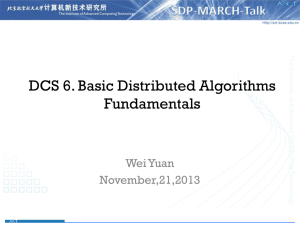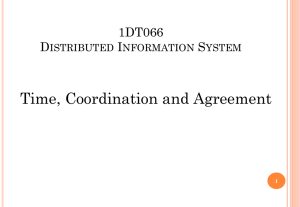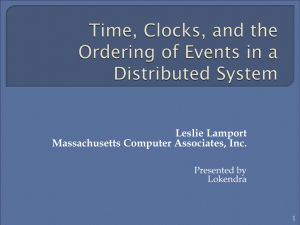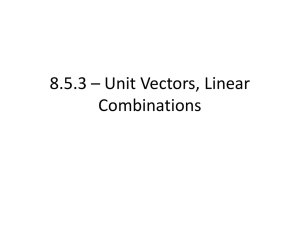Distributed Time Synchronization II
advertisement
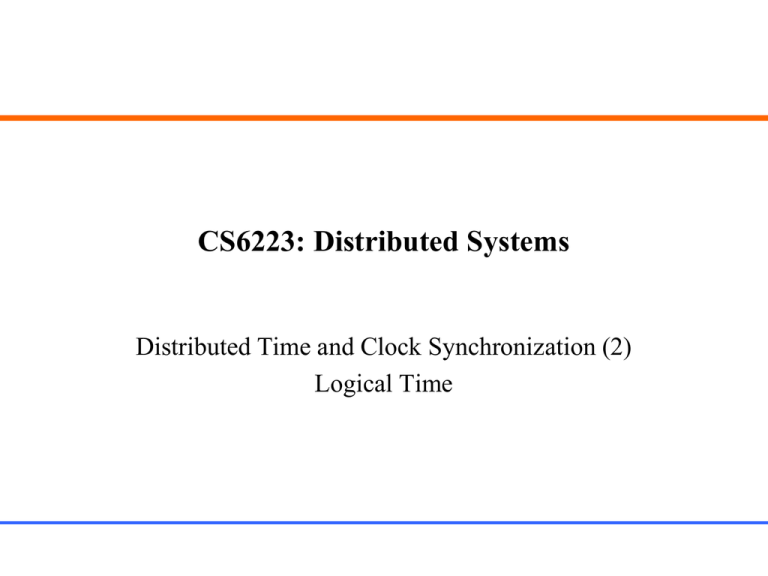
CS6223: Distributed Systems
Distributed Time and Clock Synchronization (2)
Logical Time
Motivation of logical clocks
• Cannot synchronize physical clocks perfectly in distributed
systems. [Lamport 1978]
• Main function of computer clocks – order events
– If two processes don’t interact, there is no need to sync clocks.
– This observation leads to “causality”
2
Causality
• Order events with happened-before () relation
– ab
• a could have affected the outcome of b
– a || b
• a and b take place in different processes that don’t exchange data
• Their relative ordering does not matter (they are concurrent)
3
Definition of happened-before
Definition of “” relationship:
1. If a and b take place in the same process
–
2.
If a and b take place in the different processes
–
3.
a comes before b, then a b
a is a “send” and b is the corresponding “receive”, then a b
Transitive: if a b and b c, then a c
Partial ordering – unordered events are concurrent
4
Logical Clocks
•
A logical clock is a monotonically increasing software
counter. It need not relate to a physical clock.
– Corrections to a clock must be made by adding, not subtracting
•
Rule for assigning “time” values to events
– if a b then clock(a) < clock(b)
5
Event counting example
• Three processes: P0, P1, P2, events a, b, c, …
• A local event counter in each process.
• Processes occasionally communicate with each other,
where inconsistency occurs, …
Bad ordering: e h, f k
6
Lamport’s algorithm, 1978
Each process Pi has a logical clock Li. Clock synchronization algorithm:
1. Li is initialized to 0;
2. Update Li:
–
–
–
LC1: Li is incremented by 1 for each new event happened in Pi
LC2: when Pi sends message m, it attaches t = Li to m
LC3: when Pj receives (m,t) it sets Lj := max{Lj, t} , and then applies LC1
to increment Lj for event receive(m)
7
Problem: Identical timestamps
Concurrent events (e.g., a, g) may have the same timestamp
8
Make timestamps unique
Append the process ID (or system ID) to the clock value
after the decimal point:
– e.g. if P1, P2 both have L1 = L2 = 40, make L1 = 40.1, L2 = 40.2
9
Problem: Detecting causal relations
• If a b, then L(a) < L(b), however:
• If L(a) < L(b), we cannot conclude that a b
• It is not very useful in distributed systems.
L(g) < L(c ), but g || c
• Solution: use vector clocks
10
Vector of Timestamps
Suppose there are a group of people and each needs to keep track
of events happened to others.
Requirement: Given two events, you need to tell whether they are
sequential or concurrent.
Solution: you need to have a vector of timestamps, one element
for each member.
(3,0,0)
(?,?,?)
11
Vector clocks
Each process Pi keeps a clock Vi which is a vector of N integers
• Initialization: for 1 ≤ i ≤ N and 1 ≤ k ≤ N, Vi[k] := 0
• Update Vi :
– VC1: when there is a new event in Pi, it sets Vi[i] := Vi[i] +1
– VC2: when Pi sends a message m out, it attaches t = Vi to m
– VC3: when Pj receives (m,t), for 1 ≤ k ≤ N, it sets Vj[k] := max{Vj[k], t[k]},
then applies VC1 to increment Vj[j] for event receive(m,t)
Note: Vi[j] is a timestamp indicating that Pi knows all events that
happened in Pj upto this time.
12
Vector timestamps: example
13
Vector timestamps: example
14
Vector timestamps: example
15
Vector timestamps: example
16
Vector timestamps: example
17
Vector timestamps: example
18
Vector timestamps: example
19
Detecting “” or “||” events by time vectors
• Define
V = V’ iff V[i] = V’[i]) for i = 1, …, N
V ≤ V’ iff V[i] ≤ V’[i]) for i = 1, …, N
V < V’ iff V ≤ V’ and V ≠ V’
• V(e) timestamp vector of an event e
• For any two events a and b,
– a b iff V(a) < V(b), a ≠ b
– a || b iff neither V(a) ≤ V(b) nor V(b) ≤ V(a)
20
Detecting “” or “||” events: an example
21
Summary on vector timestamps
• No need to synchronize physical clocks
• Able to order causal events
• Able to identify concurrent events (but cannot order them)
22
An Application of Timestamp Vectors:
causally-ordered multicast
Multicast: a sender sends a message to a group of receivers. Every
message must be received by all group members.
Causally ordered multicast: if m1 m2, m1 must be received before
m2 by all receivers.
(2,2,0)
(1,0,0)
(0,0,0)
(1,2,0)
(0,0,0)
(0,0,0)
(1,1,0)
(1,0,1) (1,2,2)
23
Algorithm of Causally-Ordered Multicast
Each group member keeps a timestamp vector of n components (n group members),
all initialized to 0.
1. When Pi multicasts a message m, it increments i-th component of its time vector
Vi and attaches Vi to m.
2. When Pj with Vj receives (m, Vi) from Pi:
if (Vj [k] Vi[k] for all k, k≠ i), then
Vj [i] := Vi [i]; // Vi [i] is always greater than Vj [i]
Vj [j] := Vj [j] + 1;
(2,2,0) (3,2,0)
(1,0,0)
Deliver m;
(0,0,0)
otherwise
(1,2,0)
Delay m until “if” is met.
(0,0,0)
(0,0,0)
(3,3,0)
(1,1,0)
(1,0,1) (1,2,2)
24
?
Causal-Order Preserved
• If m1 m2, m1 is received by (delivered to) all recipients before m2.
• If m1 || m2, m1 and m2 can be received in arbitrary order by recipients.
• Total ordered multicast: for case of m1 || m2, m1 and m2 must be
received in the same order by all recipients (i.e., either all m1 before
m2, or all m2 before m1).
(2,2,0)
(1,0,0)
(3,2,0)
(0,0,0)
(1,2,0)
(0,0,0)
(0,0,0)
(1,3,0)
(3,4,0)
(1,1,0)
(1,0,1)
(1,2,2)
?
(3,3,4)
25
